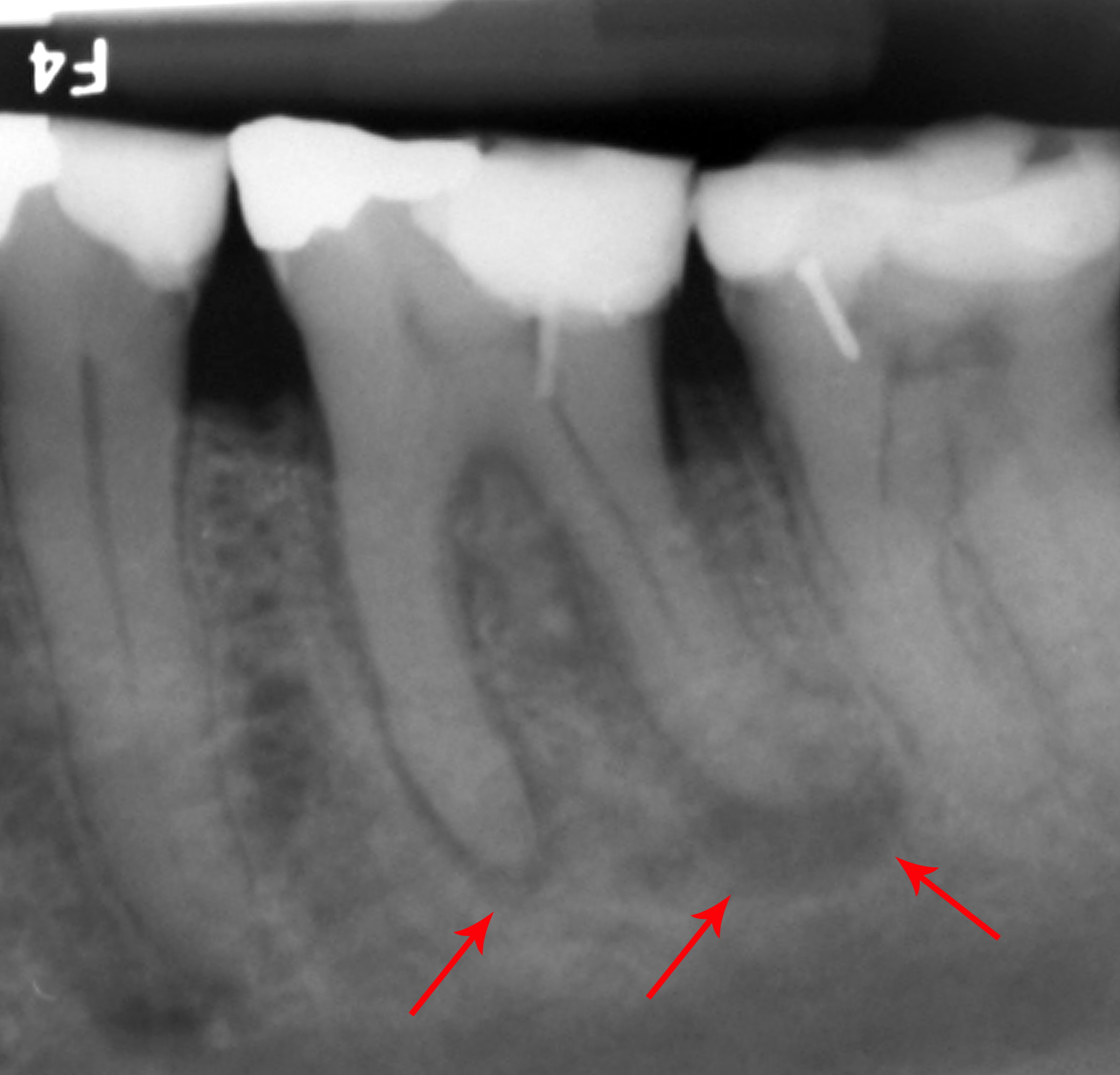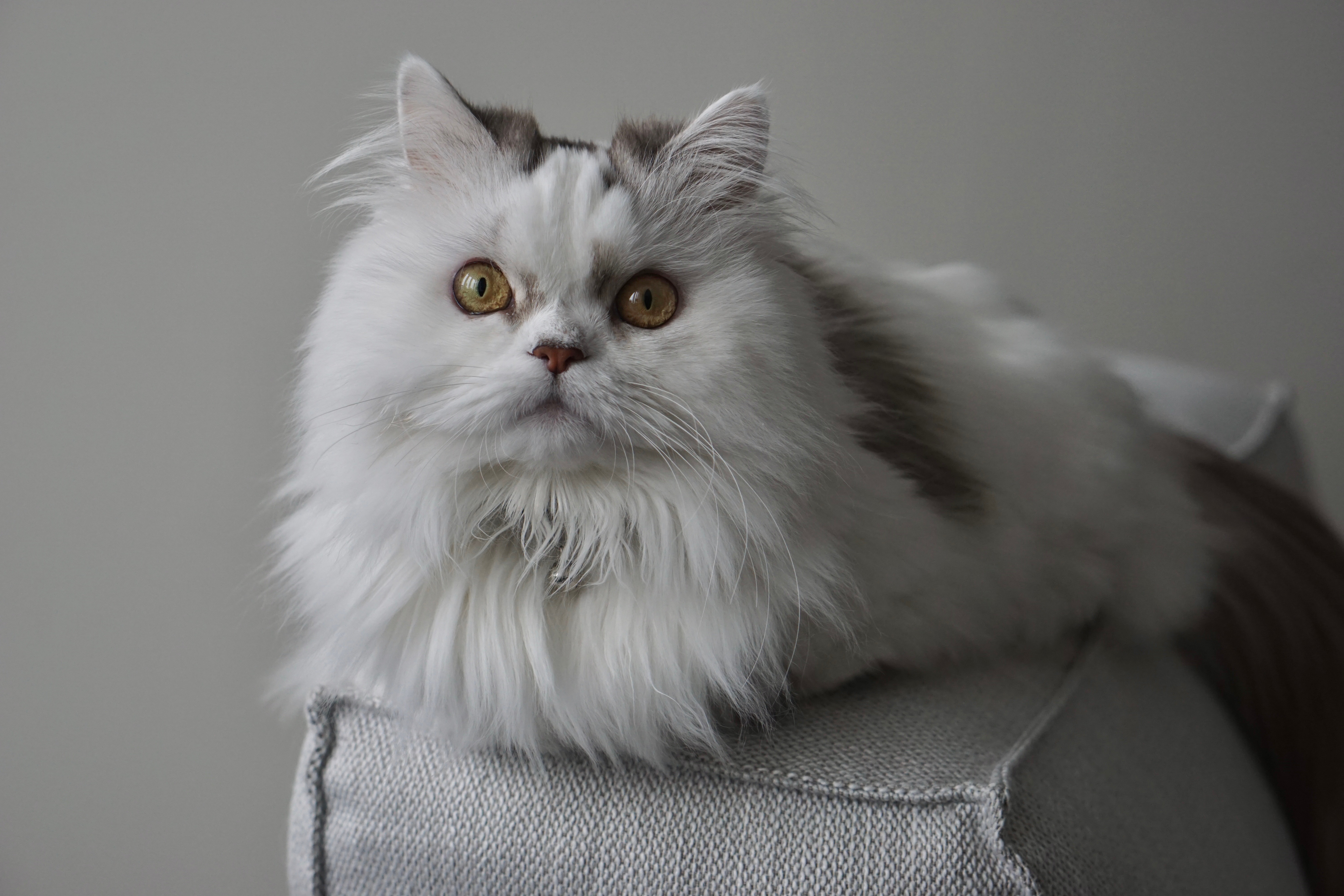|
Feline Odontoclastic Resorptive Lesion
Feline odontoclastic resorption lesion (FORL) is a syndrome in cats characterized by resorption of the tooth by odontoclasts, cells similar to osteoclasts. FORL has also been called Feline tooth resorption (TR), neck lesion, cervical neck lesion, cervical line erosion, feline subgingival resorptive lesion, feline caries, or feline cavity. It is one of the most common diseases of domestic cats, affecting up to two-thirds. FORLs have been seen more recently in the history of feline medicine due to the advancing ages of cats, but 800-year-old cat skeletons have shown evidence of this disease. Purebred cats, especially Siamese and Persians, may be more susceptible. Dental anatomy FORLs clinically appear as erosions of the surface of the tooth at the gingival border. They are often covered with calculus or gingival tissue. It is a progressive disease, usually starting with loss of cementum and dentin and leading to penetration of the pulp cavity. Resorption continues up the dentina ... [...More Info...] [...Related Items...] OR: [Wikipedia] [Google] [Baidu] |
Periodontal Ligament
The periodontal ligament, commonly abbreviated as the PDL, are a group of specialized connective tissue fibers that essentially attach a tooth to the alveolar bone within which they sit. It inserts into root cementum on one side and onto alveolar bone on the other. Structure The PDL consists of principal fibers, loose connective tissue, blast and clast cells, oxytalan fibers and cell rest of Malassez. Alveolodental ligament The main principal fiber group is the alveolodental ligament, which consists of five fiber subgroups: alveolar crest, horizontal, oblique, apical, and interradicular on multirooted teeth. Principal fibers other than the alveolodental ligament are the transseptal fibers. All these fibers help the tooth withstand the naturally substantial compressive forces that occur during chewing and remain embedded in the bone. The ends of the principal fibers that are within either cementum or alveolar bone proper are considered Sharpey fibers. * Alveolar cre ... [...More Info...] [...Related Items...] OR: [Wikipedia] [Google] [Baidu] |
Dental Caries
Tooth decay, also known as caries,The word 'caries' is a mass noun, and is not a plural of 'carie'.'' is the breakdown of teeth due to acids produced by bacteria. The resulting cavities may be a number of different colors, from yellow to black. Symptoms may include pain and difficulty eating. Complications may include periodontal disease, inflammation of the tissue around the tooth, tooth loss and infection or dental abscess, abscess formation. Tooth regeneration is an ongoing Stem-cell therapy, stem cell–based field of study that aims to find methods to reverse the effects of decay; current methods are based on easing symptoms. The cause of cavities is acid from bacteria dissolving the hard tissues of the teeth (Tooth enamel, enamel, dentin and cementum). The acid is produced by the bacteria when they break down food debris or sugar on the tooth surface. Simple sugars in food are these bacteria's primary energy source and thus a diet high in simple sugar is a risk factor. I ... [...More Info...] [...Related Items...] OR: [Wikipedia] [Google] [Baidu] |
Alendronate
Alendronic acid, sold under the brand name Fosamax among others, is a bisphosphonate medication used to treat osteoporosis and Paget's disease of bone. It is taken by mouth. Use is often recommended together with vitamin D, calcium supplementation, and lifestyle changes. Common side effects (1 to 10% of patients) include constipation, abdominal pain, nausea, and acid reflux. Use is not recommended during pregnancy or in those with poor kidney function. Alendronic acid works by decreasing the activity of cells that break down bone. Alendronic acid was first described in 1978 and approved for medical use in the United States in 1995. It is available as a generic medication. In 2022, it was the 103rd most commonly prescribed medication in the United States, with more than 6million prescriptions. Medical uses Alendronic acid is indicated for the treatment and prevention of osteoporosis in postmenopausal women; the treatment to increase bone mass in men with osteoporosis; the ... [...More Info...] [...Related Items...] OR: [Wikipedia] [Google] [Baidu] |
Dental Restoration
Dental restoration, dental fillings, or simply fillings are treatments used to restore the function, integrity, and morphology of missing tooth structure resulting from caries or external trauma as well as the replacement of such structure supported by dental implants. They are of two broad types—''direct'' and ''indirect''—and are further classified by location and size. Root canal therapy, for example, is a restorative technique used to fill the space where the dental pulp normally resides and are more hectic than a normal filling. History In Italy evidence dated to the Paleolithic, around 13,000 years ago, points to bitumen used to fill a tooth and in Neolithic Slovenia, 6500 years ago, beeswax was used to close a fracture in a tooth. Graeco-Roman literature, such as Pliny the Elder's Naturalis Historia (AD 23–79), contains references to filling materials for hollow teeth. Tooth preparation Restoring a tooth to good form and function requires two steps: # prepari ... [...More Info...] [...Related Items...] OR: [Wikipedia] [Google] [Baidu] |
Radiography
Radiography is an imaging technology, imaging technique using X-rays, gamma rays, or similar ionizing radiation and non-ionizing radiation to view the internal form of an object. Applications of radiography include medical ("diagnostic" radiography and "therapeutic radiography") and industrial radiography. Similar techniques are used in airport security, (where "body scanners" generally use backscatter X-ray). To create an image in conventional radiography, a beam of X-rays is produced by an X-ray generator and it is projected towards the object. A certain amount of the X-rays or other radiation are absorbed by the object, dependent on the object's density and structural composition. The X-rays that pass through the object are captured behind the object by a X-ray detector, detector (either photographic film or a digital detector). The generation of flat two-dimensional images by this technique is called Projection radiography, projectional radiography. In computed tomography (C ... [...More Info...] [...Related Items...] OR: [Wikipedia] [Google] [Baidu] |
Extraction (dental)
A dental extraction (also referred to as tooth extraction, exodontia, exodontics, or informally, tooth pulling) is the removal of teeth from the dental alveolus (socket) in the alveolar bone. Extractions are performed for a wide variety of reasons, but most commonly to remove teeth which have become unrestorable through tooth decay, periodontal disease, or dental trauma, especially when they are associated with toothache. Sometimes impacted wisdom teeth (wisdom teeth that are stuck and unable to grow normally into the mouth) cause recurrent infections of the gum ( pericoronitis), and may be removed when other conservative treatments have failed (cleaning, antibiotics and operculectomy). In orthodontics, if the teeth are crowded, healthy teeth may be extracted (often bicuspids) to create space so the rest of the teeth can be straightened. Procedure Extractions could be categorized into non-surgical (simple) and surgical, depending on the type of tooth to be removed a ... [...More Info...] [...Related Items...] OR: [Wikipedia] [Google] [Baidu] |
Russian Blue
The Russian Blue cat (), commonly referred to as just Russian Blue, is a pedigreed cat breed with solid blue colours that vary from a light shimmering silver to a darker, slate grey. The short, dense coat, which stands out from the body, has been the breed's hallmark for more than a century. Origin The Russian Blue is a Landrace, naturally occurring breed that may have originated in the port of Arkhangelsk in Russia.. They are also sometimes called Archangel Blues. It is believed that sailors took them from the Archangel Isles to Great Britain and Northern Europe in the 1860s. The first reference to an Archangel Cat appears in British print in 1862. The first recorded appearance of one in a show was in 1872 at The Crystal Palace in England as the Archangel Cat. However, Harrison Weir writing in 1895 reported that the early show cats under the Russian Blue name were British-bred grey tabbies, with separate grey cats arriving from Archangel in Britain in the 1800s with feature ... [...More Info...] [...Related Items...] OR: [Wikipedia] [Google] [Baidu] |
Siamese Cat
The Siamese cat (; แมวสยาม, Maeo Sayam; แมววิเชียรมาศ, Maeo Wichien Maat) is one of the first distinctly recognised breeds of Asian cat. It derives from the Wichianmat landrace. The Siamese cat is one of several varieties of cats native to Thailand (known as Siam before 1939). The original Siamese became one of the most popular breeds in Europe and North America in the 19th century. Siamese cats have a distinctive colourpoint coat, resulting from a temperature-sensitive type of albinism. Distinct features like blue almond-shaped eyes, a triangular head shape, large ears, an elongated, slender, and muscular body, and various forms of point colouration characterise the modern-style Siamese. The modern-style Siamese's point-colouration resembles the "old-style" foundation stock. The "old-style" Siamese have a round head and body. They have been re-established by multiple registries as the Thai cat. Siamese and Thai cats are selectively ... [...More Info...] [...Related Items...] OR: [Wikipedia] [Google] [Baidu] |
Abyssinian Cat
The Abyssinian is a breed of cat with a distinctive "ticked" tabby coat, in which individual hairs are banded with different colours. They are also known simply as Abys. The first members of the breed to be exhibited in England were brought there from Abyssinia (now known as Ethiopia), hence the name. Genetic studies place the breed's origins in Southeast Asia and the coasts of the Indian Ocean, however. It is possible that the breed was introduced to Abyssinia by travelers who had stopped in Calcutta. Once a comparatively obscure breed, the Abyssinian had become one of the top five most popular cat breeds by 2016. The breed's distinctive appearance, seeming long, lean and finely coloured compared to other cats, has been analogized to that of human fashion models. Personality-wise, the cats traditionally display active, curious attitudes in which they frequently follow owners around and encourage play. Their dog-like characteristics also involve a particular sense of affec ... [...More Info...] [...Related Items...] OR: [Wikipedia] [Google] [Baidu] |
Scottish Fold
The Scottish Fold is a distinctive List of cat breeds, breed of Cat, domestic cat characterised by a natural Dominance (genetics), dominant gene mutation associated with osteochondrodysplasia. This genetic anomaly affects cartilage throughout the body, causing the Cat anatomy, ears to "fold", bending forward and down towards the front of the head. While this trait contributes to the breed's unique appearance, often described as "owl-like", it also causes health problems. The breed's name, originally Lop-ears or Lops after the Lop rabbit, lop-eared rabbit, became ''Scottish Fold'' in 1966. Depending on registries, longhaired Scottish Folds are varyingly known as Highland Fold, Scottish Fold Longhair, Longhair Fold, and Coupari. Research has revealed that all Scottish Fold cats are affected by osteochondrodysplasia, a Birth defect, developmental abnormality that affects cartilage and bone development throughout the body. This condition causes the ear fold as well as malformed bon ... [...More Info...] [...Related Items...] OR: [Wikipedia] [Google] [Baidu] |
Persian Cat
The Persian cat, also known as the Persian Longhair, is a long-haired breed of cat characterised by a round face and short muzzle. The first documented ancestors of Persian cats might have been imported into Italy from Greater Khorasan, Khorasan as early as around 1620, but this has not been proven. Instead, there is stronger evidence for a longhaired cat breed being exported from Afghanistan and Iran, Iran/Persia from the 19th century onwards. Persian cats have been widely recognised by the North-West European Cat culture, cat fancy since the 19th century, and after World War II by breeders from North America, Australia and New Zealand. Some cat fancier organisations' breed standards subsume the Himalayan cat, Himalayan and Exotic Shorthair as variants of this breed, while others generally treat them as separate breeds. The selective breeding carried out by breeders has allowed the development of a wide variety of coat colours, but has also led to the creation of increasingly ... [...More Info...] [...Related Items...] OR: [Wikipedia] [Google] [Baidu] |







